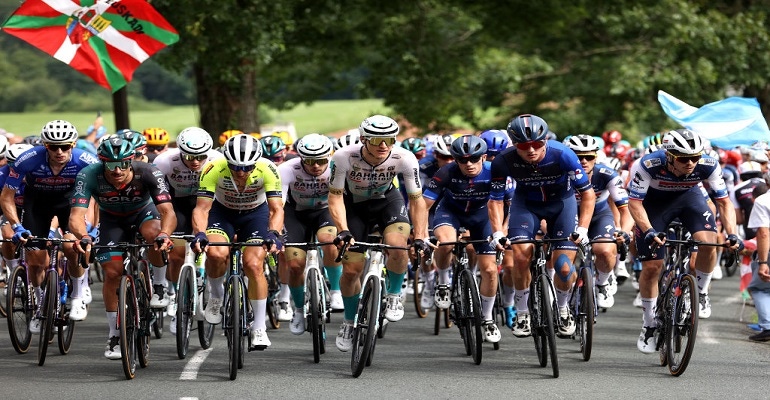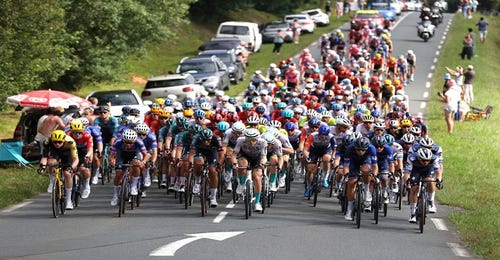The Tour de France Races into Cutting-Edge Technology
The classic bike race gets a tech boost of AI and digital analytics to enhance the fan’s experience.
July 3, 2023

The Tour de France (TdF) has gone high digital to bring the experience alive for fans this year. NTT will transform the TdF viewing experience by leveraging IoT, edge computing, and AI to deliver a large and extended “connected stadium.” Sports has a long history as a test bed for innovative and emerging technologies that can enhance the viewer experience. This year, NTT is engaging cutting-edge tech to take TdF into the digital world.
The TdF organizer, the Amaury Sport Organisation (A.S.O.), has engaged its long-term partner NTT to roll out new technology to enhance the fan experience. “For the ninth year running, NTT is supporting A.S.O to deliver innovative and digital sports experiences powered by IoT, edge computing, and real-time analytics,” Joan Kuhrmann, director of program management at NTT, told Design News. “Notably, data has become a cornerstone of the fan experience and with it, we’re able to bring rider performance to life with visualizations and predictive analytics for social media, broadcasters, and mobile screens around the world.”

NTT is delivering a wide range of its technology and digital processes to the multi-day bike race. “Our partnership with A.S.O. is an end-to-end showcase of what NTT does best: cloud, data analytics, machine learning and AI, edge computing, cybersecurity, IoT, managed services, collaboration services, IT management, and smart venues,” said Kuhrmann. “We’re using our experience to provide fans at home and on the roadside with the premier TdF viewing experience.”
Here are some of the elements of the connected stadium:
ChatGPT Integration
This year, NTT is introducing Marianne, the company’s AI-driven digital-human solution. Marianne combines machine learning, speech recognition, natural language processing, and conversational AI. The digital-human platform has been specifically trained on relevant race information and can access detailed information to further enhance the fan experience. “The platform is named after Marianne Martin, the first woman to win the Tour de France Féminin in 1984,” said Kuhrmann. “This AI-based avatar has been specially trained on relevant race information and leverages ChatGPT to answer fan questions about the race, the venue, team information, who is the favorite to win the stage or overall race, and more. Looking ahead, we see more opportunities to integrate Marianne across the TdF arrival and departure villages and potentially enrich the TdF app.”
The Digital Twin Stadium
Now a fully digitized event, the TdF digital twin connects layers of real-time information to replicate all aspects of the highly dynamic event digitally. At 3,400 km of people, operations, and assets, the digital twin of the Tour de France gives the A.S.O. a view of what’s going on and where so they can ensure a smooth event. “Utilizing the power of IoT, edge computing, and cloud, NTT enables the world’s largest connected stadium, virtualizing the intensity of the race for viewers at home,” said Kuhrmann. “The digital twin brings together over 3,400 KM of people, operations, and assets to provide the A.S.O with a big-picture view of the entire race.
Real-Time Data Analytics
At the core of NTT’s data-gathering are the bikes themselves. Using geolocation, the tiny sensors mounted beneath the saddle of each rider’s bike will transmit a constant stream of latitude, longitude, speed, time gaps, and weather data over radio networks to race motorcycles and aircraft. A microwave signal will then carry the data to the end of the race, where a truck-based edge-computing device will run a containerized version of NTT’s real-time analytics platform. All within milliseconds.
The data analytics will be engaged throughout the entire race. “No matter where riders are during the race, NTT’s real-time analytics platform leverages the bikes themselves as data-gathering points,” said Kuhrmann. “Using geolocations, the small sensors mounted beneath the saddle of each rider’s bike will transmit a constant stream of latitude, longitude, and speed over radio networks to race motorcycles and aircraft.”
The data analytics use microwave signals to deliver instant connections to the platform. “Data is then sent through a microwave signal to the end of the race, where a truck-based edge computing device will run a containerized version of our real-time analytics platform,” said Kuhrmann. “This all happens within milliseconds, providing fans, race organizers, and team members with deep race insights.”
About the Author(s)
You May Also Like





